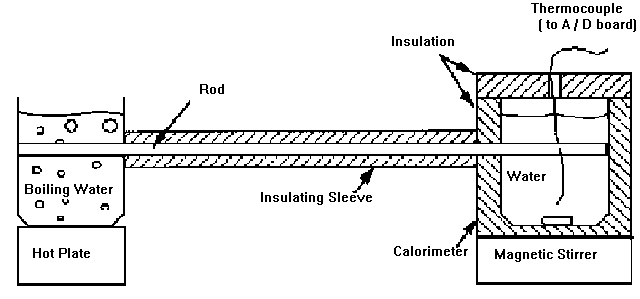

One-Dimensional Heat Transfer and the Heat Pipe


Objectives
1. Gain exposure to the heat pipe, a relatively new device in heat-transfer technology.
2. Evaluate the effective thermal conductivity of the heat pipe by measuring heat flux with a calorimeter. Compare this result to that obtained for three metal rods of the same length and cross-sectional area.
3. Gain experience using thermocouples as a method of measuring temperature and use a computerized data acquisition system to record temperatures as functions of time.
4. Model the experimental set up as a steady one-dimensional heat transfer problem and use the method of thermal resistance to create a circuit analog to calculate the thermal conductivities for the three metal rods: copper, cartridge brass, and aluminum.
Procedure
Using the experimental set-up shown in Fig. 1, measure the axial heat flux (heat transfer per unit time per unit area) through a heat pipe and rods of aluminum, brass, and copper. Also determine the thermal conductivity for the metal rods. The steps are listed below:
1. Launch the software "SuperScope" from the directory "SuperScope1.84".
2. Select "File•Load Config" command from menu. Choose the configuration file "Heat Pipe Experiment" from the directory"SuperScope 1.84". There are two thermocouples inputs, TC1 and TC2, displayed on the two panels. The thermocouples are labeled correspondingly.
3. Turn on the switch on the back of the MacADIOS-8ain A/D converter.
4. To save time you can measure the heat flux for two different rods simultaneously by using two experimental stations and thermocouples TC1 and TC2. Begin with specimen rods in place and calorimeters empty. Insure that the water is boiling.
5. Click "Start" in the control box on the SuperScope screen. Immediately add 0.75 kg of cool (~ room temperature) water to each calorimeter. Turn on the magnetic stirrers. SuperScope will begin taking data every 10 seconds for about 20 minutes. A strip chart recording of temperature vs. time chart will be plotting on the screen.
6. While you are waiting for the computer to finish acquiring data, obtain the necessary data to allow you to theoretically predict steady-state heat transfer by using the thermal resistance method. You will need an estimate of heat transfer coefficients for the hot and cold ends of the rod. To obtain this you will need, at a minimum:
i) estimates of water velocity,
ii) measurements of the wetted area of the rod

Figure 1. Experiment Set-up
7. Saving heat pipe experiment files on the experiment PC.
Journal
Save journal as TC
Desktop (open)
ME 372B (open)
Students Lab (A or B) (open)
Group 1-4 (open)
Type file name to save.JO(save)
On the power PC
ME 372B (open)
Students Lab (A or B) (open)
Group 1-4 (open)
Insert diskette
Transfer select file to diskette
Note: You should bring a diskette to lab with you to save your data.
Report
1. Use the SuperScope data to make a single plot of temperature versus time for all four test runs.
2. Analyze these data for transient and steady-state heat transfer. Describe what the curves would look like if this were purely steady-state heat transfer. There are at least two sources of unsteadiness in this experiment. Discuss them and how they influence the shape of the curves.
3. Choose an appropriate location on your temperature plots to obtain the slope of the curves and use this to calculate the steady state heat flux in kW/m2 for each rod.
4. Calculate the thermal conductivity for the three metal rods using the thermal resistance method. Compare these to tabulated values. Make any simplifying assumptions that are necessary to obtain heat transfer coefficients for the hot and cold ends of the rod. Compare the magnitude of the resistances of each component of your "circuit" and discuss whether your results are sensitive to your assumptions for the heat transfer coefficients. Include an error analysis in your report.
5. Compare the theoretical and experimental results. Discuss why they might differ?
Appendix A: Data Acquisition System
The components of the data acquisition system are:
• Macintosh II computer with data acquisition software: SuperScope 1.84.
• MacADIOS-8ain A/D converter connected to Macintosh-II with SCSI cable.
• MacADIOS ABO Analog Breakout Unit connected to MacADIOS-8ain A/D converter with 34-wire cable.
• Type-K thermocouple wires connected to screw-terminals on the MacADIOS ABO board.
References:
1. Ozisik, M. N., HEAT TRANSFER: A BASIC APPROACH, McGraw Hill Book Co., 1985.